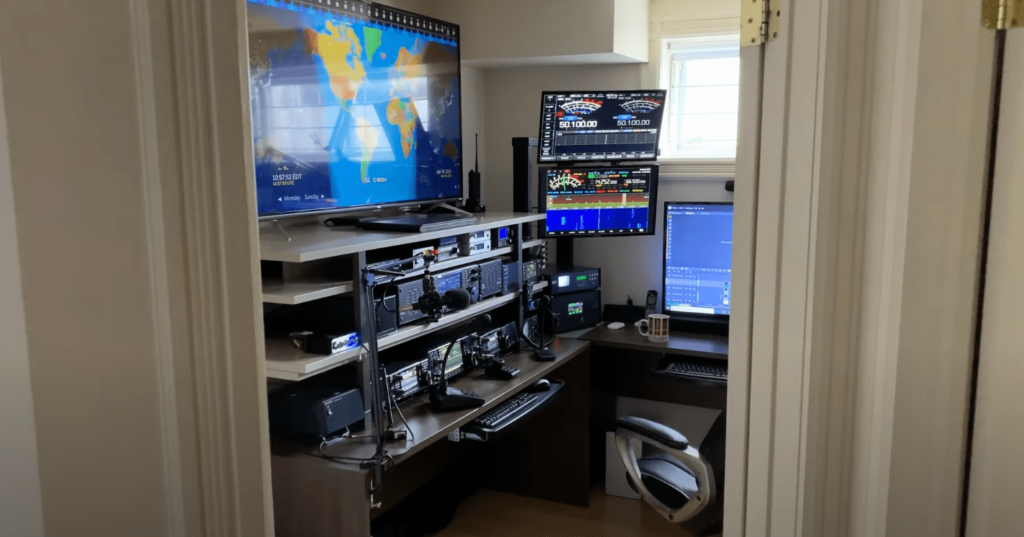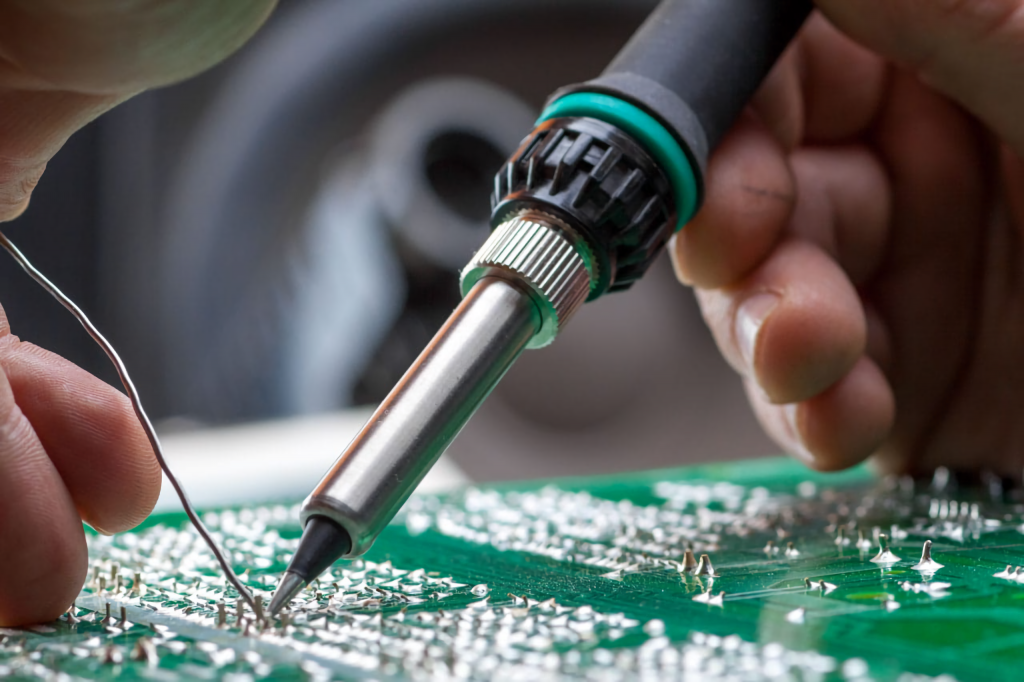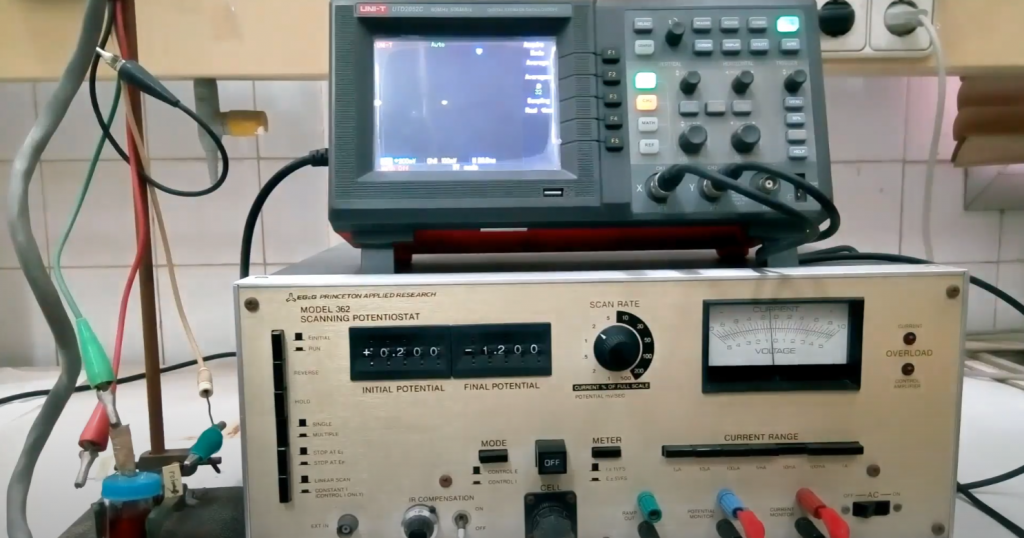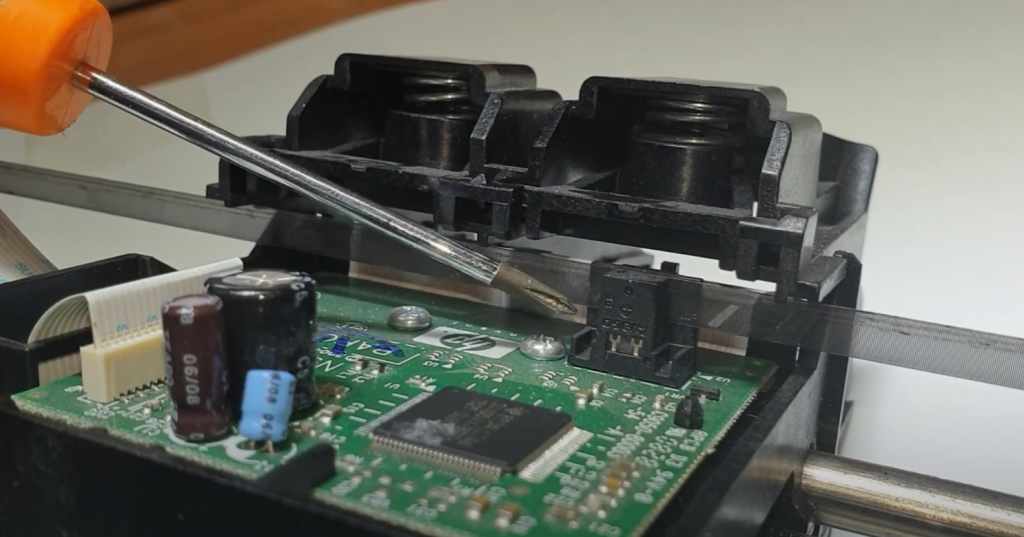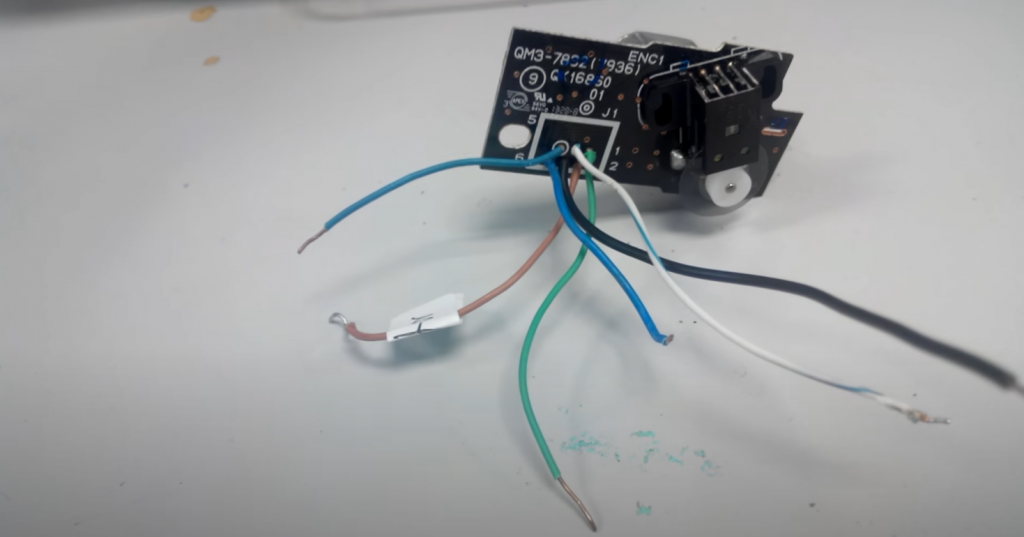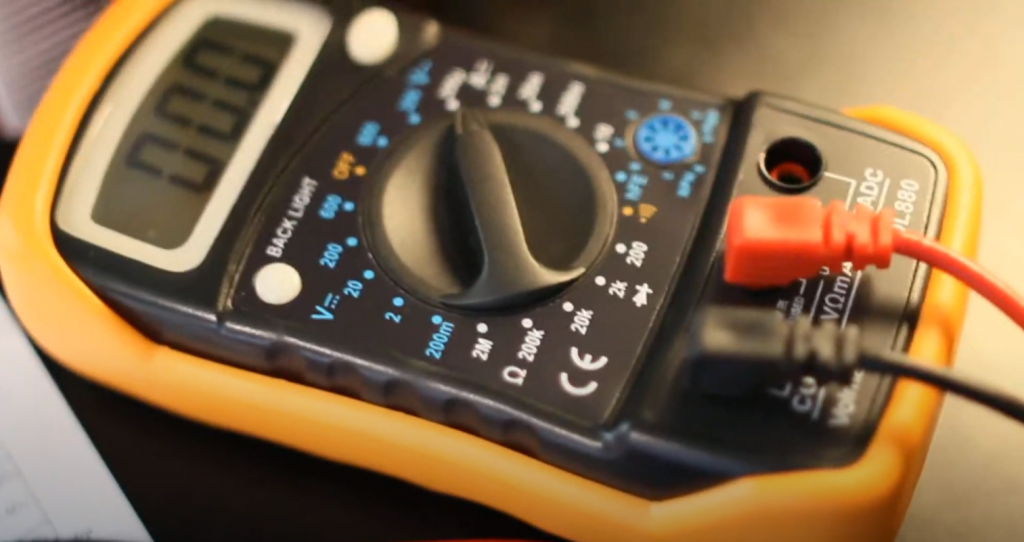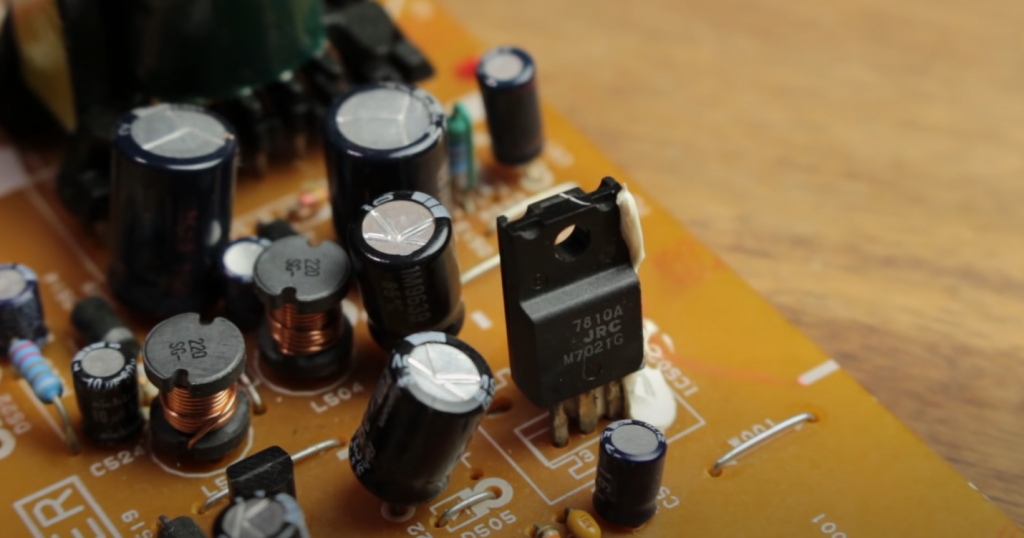Welcome to the world of ham radio desk setups, where creativity meets functionality to create the perfect operating environment. A well-designed ham radio desk can enhance your radio experience, providing an organized, comfortable space tailored to your specific needs. Whether you’re a seasoned operator or just beginning your journey into amateur radio, having a dedicated space for your equipment can significantly improve your enjoyment and efficiency.
Imagine a desk where every piece of equipment has its place, cables are neatly organized, and everything is within arm’s reach. This is where you can bring your passion for ham radio to life, surrounded by the tools and technology that connect you with fellow operators worldwide. From classic workbenches to multi-level setups, the possibilities are endless when designing your ideal ham radio desk.
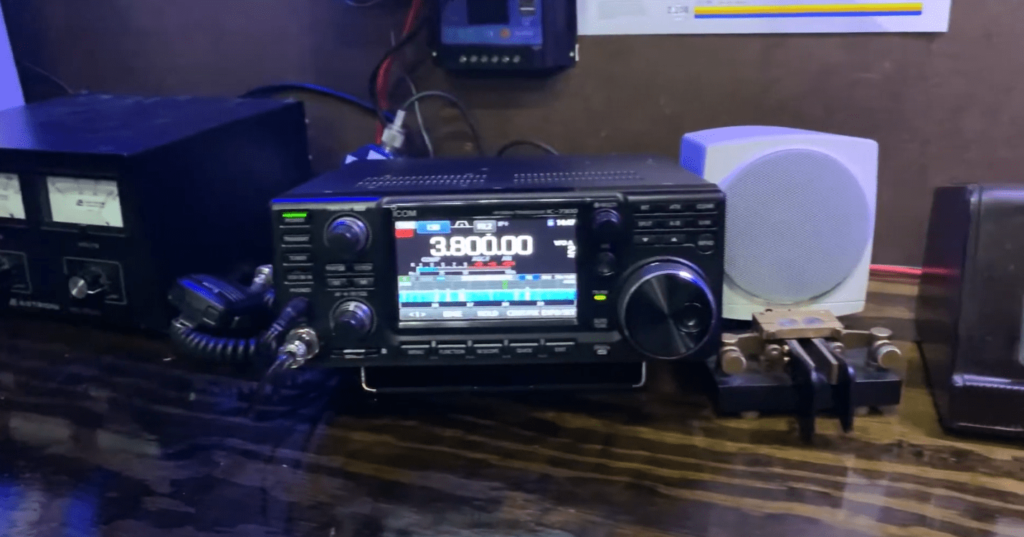
Consider the convenience of a corner desk, maximizing your available space while providing separate areas for radio equipment and computer peripherals. Or a modular desk system appeals to you, allowing you to customize and adapt the layout as your collection of equipment grows. With cable management features, ergonomic design elements, and personalized touches, you can create a space that not only meets your technical requirements but also reflects your unique style and personality.
Integrating additional features like antenna switching matrices, weather station displays, and voice-activated assistants adds functionality and convenience to your setup. These innovations can streamline your operations, enhance situational awareness, and create a truly immersive ham radio experience.
Whether you’re a DX enthusiast, a digital mode aficionado, or an all-around ham radio enthusiast, the proper desk setup can elevate your hobby to new heights. With careful consideration and creativity, you can transform your operating space into a sanctuary of communication, exploration, and connection.
So, let your imagination run wild as you explore these ham radio desk ideas. Let them inspire you to create a space that embodies your passion for amateur radio, empowering you to embark on countless adventures in radio waves. The world is waiting to hear your signal – now it’s time to design the perfect desk to bring your ham radio dreams to life.
Classic Workbench
A classic workbench is a foundation for a functional and efficient ham radio operating space. It provides a sturdy platform to support your equipment while offering ample workspace for various tasks, from equipment maintenance and repairs to logging and station control.
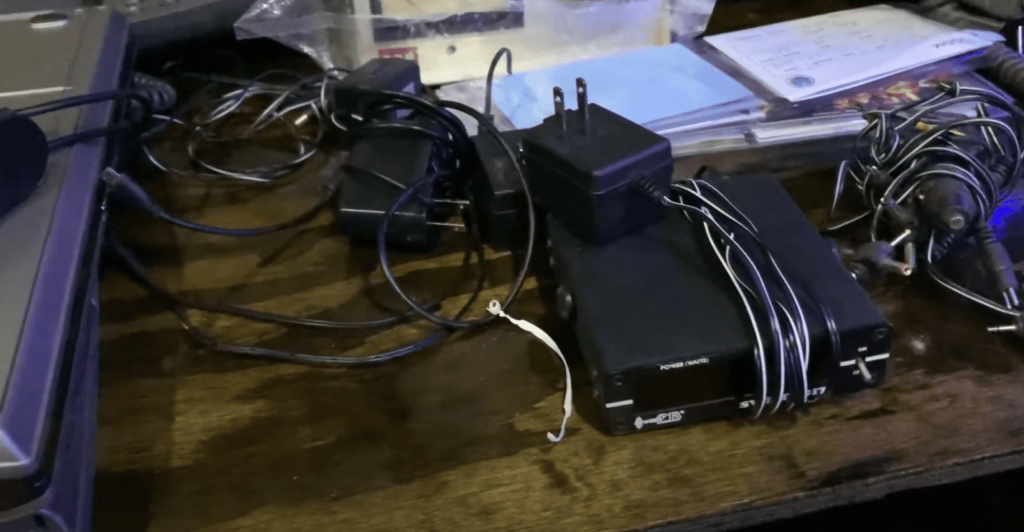
When designing your classic workbench, consider the following aspects:
- Size and Layout: Choose a workbench with sufficient surface area to accommodate your equipment, including radios, amplifiers, power supplies, and any other accessories you may have. Consider the dimensions of your room and ensure the workbench fits comfortably within the available space. Determine the best layout for you, considering the reachability of your most frequently used items.
- Construction and Durability: Opt for a workbench made from high-quality materials that can withstand the weight of your equipment and provide long-lasting durability. Look for sturdy construction, reinforced corners, and a robust tabletop surface that can handle the demands of your ham radio activities.
- Storage and Organization: Incorporate multiple shelves, drawers, or compartments into your workbench design to store and organize cables, tools, spare parts, and other accessories. This helps keep your workspace clutter-free and ensures that everything is easily accessible when needed.
- Cable Management: Integrate cable management solutions into your workbench design to prevent tangling and maintain a neat appearance. Built-in cable channels, hooks, or trays can help route and secure cables, reducing the risk of accidental damage and making identifying and troubleshooting issues easier.
- Lighting: Install proper lighting above or around your workbench to ensure optimal visibility when working with small components or performing delicate tasks. Consider using adjustable LED lights or task lamps that can be positioned to illuminate specific areas as needed.
- Power Outlets: Ensure your workbench has sufficient power outlets and surge protection to accommodate all your equipment. This allows for easy access to power your radios, chargers, and other devices, eliminating the need for long extension cords.
- Instrumentation and Measurement Tools: Dedicate a section of your workbench to instrumentation and measurement tools such as multimeters, oscilloscopes, and signal generators. Install appropriate holders or mounts to keep them organized and within reach, facilitating quick and accurate measurements when required.
- Reference Materials: Allocate space for reference materials like operating manuals, technical guides, and frequency charts. Consider mounting a whiteboard or bulletin board to pin important information or make quick notes about your operating activities.
- Personalization: Add a personal touch to your workbench by displaying QSL cards, awards, or photos of memorable contacts and experiences. These elements can inspire and remind you of your accomplishments as a ham radio operator.
Remember, the classic workbench is the heart of your ham radio station, providing a solid foundation for your operations. Customize it to suit your specific needs and preferences, creating a workspace that promotes efficiency, organization, and comfort as you communicate with the world through the airwaves.
Multi-Level Desk
A multi-level desk offers a practical and efficient solution for organizing your ham radio equipment and optimizing your operating experience. Different height surfaces allow you to segregate and arrange your gear based on functionality, making it easier to access and operate your equipment.
Consider the following aspects when designing your multi-level desk:
- Upper Level: Dedicate the upper level of the desk for your primary radio equipment. This level should provide ample space for your transceiver, microphone, and any other essential components you frequently use during your radio operations. Consider installing a stand or rack to hold your radio at a comfortable height and angle for easy viewing and operation.
- Middle Level: Use the middle level of the desk for additional equipment such as amplifiers, power supplies, antenna tuners, and other devices that are directly connected to your radio. This level can also accommodate secondary radios or digital mode equipment. Ensure there is sufficient space to accommodate the size and weight of these components and allow for proper ventilation to prevent overheating.
- Lower Level: The lower level of the desk can be used for storage, organizing cables, and housing peripherals such as computer towers, audio interfaces, and logging equipment. Consider incorporating shelves or drawers to keep these items neatly organized and easily accessible. Cable management features, such as built-in cable channels or grommets, can keep the cables organized and prevent them from tangling.
- Monitor Placement: Depending on your preference and available space, you can either place your monitors on the upper level of the desk, ensuring they are at eye level for comfortable viewing, or use monitor arms to mount them on the desk or wall, allowing for greater flexibility in positioning.
- Ergonomics: Pay attention to ergonomic considerations when setting up your multi-level desk. Ensure that the height of each level is comfortable for your seated position, allowing for proper alignment of your wrists, arms, and back. Consider using an ergonomic chair that provides support and promotes good posture during long operating sessions.
- Lighting: Incorporate appropriate lighting for each desk level to ensure optimal visibility. Task lightings, such as adjustable LED lamps or overhead lights, can be positioned to illuminate specific areas based on your needs. Consider using adjustable color temperature lights to create a comfortable and productive environment.
- Accessibility and Reachability: Arrange your equipment in a way that allows for easy access and reachability. Frequently used items should be within arm’s reach to minimize unnecessary movement and optimize your operating efficiency.
- Personalization: Add personal touches to your multi-level desk setup by including items such as QSL card displays, station call signage, or decorative elements that reflect your style and interests.
A well-designed multi-level desk provides a practical organization solution and a visually appealing and comfortable operating environment. It gives you a clear view of your equipment, facilitates efficient workflow, and enhances your overall ham radio experience.
Corner Desk Setup
A corner desk setup is an excellent choice for creating a compact and functional ham radio operating space while maximizing limited room space. Here are some considerations to expand on this idea:
- Space Optimization: Utilize the corner of your room effectively by choosing a corner desk that fits the dimensions of the space. This allows you to maximize available room while providing a dedicated area for your ham radio equipment.
- Equipment Arrangement: Designate one side of the desk for your radio equipment, such as your transceiver, microphone, and accessories. Arrange them in a way that ensures easy reach and visibility. Consider using shelves, racks, or drawers to keep everything organized and within arm’s reach.
- Computer and Peripherals: Allocate the other side of the desk for your computer setup, including your monitor, keyboard, and other peripherals. Position your monitor at eye level to maintain ergonomic comfort during extended operating sessions. Consider using monitor arms or mounts to save space and adjust the positioning.
- Cable Management: Implement cable management solutions to keep your corner desk tidy and free from cable clutter. Use cable clips, cable trays, or built-in cable channels to route and secure your cables, preventing tangling and making it easier to troubleshoot any issues.
- Storage Solutions: Maximize the storage potential of your corner desk by incorporating drawers, shelves, or cubbies. These can be used to store spare cables, tools, reference materials, and other accessories. Keep frequently used items within easy reach to streamline your operations.
- Illumination: Ensure proper lighting for your corner desk setup for optimal visibility. Place task lighting or adjustable desk lamps strategically to illuminate specific workspace areas. Consider utilizing natural daylight or adjustable LED lights to create a comfortable and productive environment.
- Personal Touches: Infuse your corner desk setup with personal touches that reflect your passion for ham radio. Display QSL cards, awards, or mementos from memorable contacts. Incorporate a call sign plaque or other decorative elements to add a sense of individuality to your operating space.
- Ergonomics: Prioritize ergonomics to maintain comfort and prevent fatigue during extended operating sessions. Use an ergonomic chair with proper back support, and adjust the height of your desk and chair to ensure proper alignment of your arms, wrists, and back.
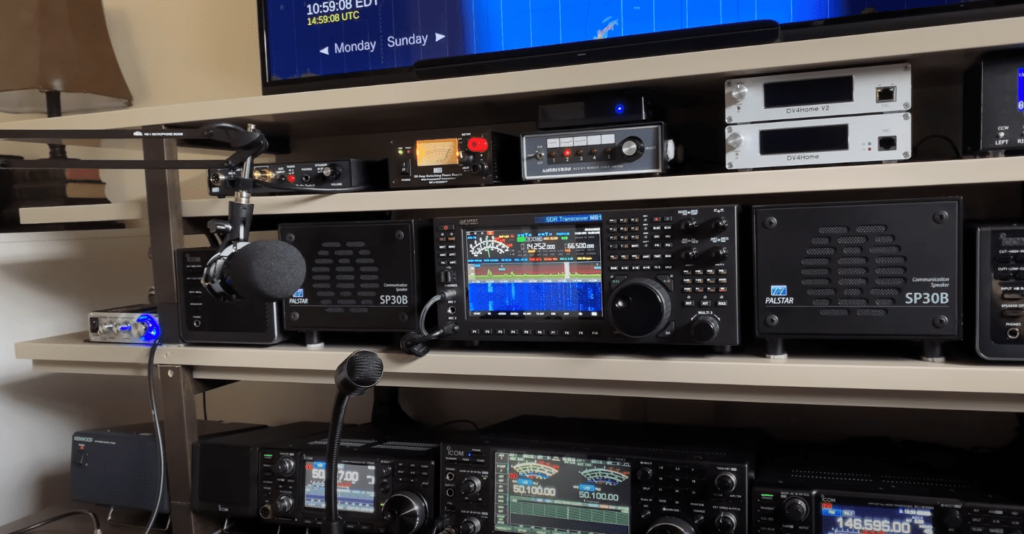
A thoughtfully designed corner desk setup optimizes your workspace, allowing for efficient organization, easy access to equipment, and a comfortable operating experience. Customizing it to your needs and preferences makes your corner desk a functional and personalized hub for your ham radio activities.
Modular Desk System
A modular desk system offers a versatile and adaptable solution for your ham radio station, allowing you to customize and modify your setup as your needs evolve. Its flexible design allows a modular desk system to arrange and rearrange components to create an optimal operating environment. Here’s a description of the modular desk system idea:
- Configurable Design: A modular desk system consists of individual modules or components that can be mixed and matched to create a configuration that suits your specific requirements. These modules can include desk surfaces, shelving units, drawers, and storage compartments. The beauty of a modular system lies in its ability to be expanded, reconfigured, or scaled down as needed, providing flexibility and adaptability to accommodate changes in your equipment or operating style.
- Customizable Layout: With a modular desk system, you can design a layout that maximizes efficiency and workflow. You can choose the number and size of the modules to fit your available space. For example, you can have separate sections for your radio equipment, computer setup, and storage or integrate them into a single cohesive unit. This customization allows you to create a personalized operating space that caters to your specific needs and preferences.
- Easy Assembly and Disassembly: Modular desk systems are designed for easy assembly and disassembly, often without the need for complex tools or specialized skills. The individual components typically come with connectors or fasteners that allow for quick and secure attachment. This makes it convenient to adjust or reconfigure your desk setup whenever desired, enabling you to experiment with different layouts or accommodate changes in your station’s equipment.
- Expandability and Upgradability: One of the significant advantages of a modular desk system is its ability to accommodate expansion and upgrades. As your ham radio station grows, you can easily add new modules to increase workspace or storage capacity. This scalability ensures that your desk setup can evolve alongside your equipment collection and operating needs without requiring a complete overhaul.
- Cable Management: Modular desk systems often incorporate built-in cable management features to keep your workspace organized and free from tangled cables. These features can include cable channels, grommets, or wire trays that help route and conceal cables, reducing clutter and simplifying maintenance.
- Personalization: Modular desk systems can be personalized with additional accessories and decorative elements. You can add monitor arms, keyboard trays, or lighting fixtures to enhance ergonomics and productivity. Furthermore, you can personalize the aesthetics of your desk with color choices, finishes, or customized add-ons to match your style.
- Portability: Depending on the specific modular desk system, some designs may offer portability, allowing you to disassemble and move the components if needed. This feature can be advantageous if you anticipate changes in your operating location or prefer the flexibility to reposition your desk setup within the same space.
A modular desk system provides the flexibility and adaptability to create a customized ham radio station that evolves with your needs. Its configurable design, ease of assembly, and expandability make it a versatile choice for operators who value versatility, organization, and the ability to adapt to changing requirements.
Vertical Equipment Rack
The vertical equipment rack is a space-saving and efficient solution for organizing and housing your ham radio equipment. Instead of utilizing horizontal surfaces, this rack design maximizes vertical space, allowing you to store and access your equipment in a compact and organized manner. Here’s a description of the vertical equipment rack idea:
- Vertical Storage: The primary feature of a vertical equipment rack is its upright design, which allows you to stack your equipment vertically. This design optimizes vertical space, making it ideal for setups with a limited floor area or for those who prefer a streamlined and efficient arrangement.
- Rack Structure: The rack typically consists of a sturdy framework with multiple shelves or compartments for housing your equipment. The shelves can be adjustable to accommodate various-sized devices, such as radios, amplifiers, power supplies, antenna tuners, and other accessories. The rack structure ensures stability and support for the weight of your equipment.
- Accessibility and Organization: The vertical arrangement of the equipment provides easy visibility and accessibility to each device. You can arrange your gear logically, placing frequently used items at eye level or within comfortable reach. This allows for efficient operation and simplifies maintenance and troubleshooting tasks.
- Cable Management: Effective cable management is crucial in a vertical equipment rack setup. Built-in cable management features, such as cable routing channels or hooks, help keep cables organized and prevent tangling. Proper cable management not only improves the aesthetics of your setup but also reduces the risk of accidental cable damage and makes it easier to trace and troubleshoot connections.
- Ventilation and Cooling: Adequate ventilation is essential to prevent equipment overheating. A well-designed vertical equipment rack provides proper airflow around the devices, minimizing the risk of heat buildup. Ventilation features such as perforated shelves or rack fans can be incorporated to enhance cooling and maintain optimal operating temperatures.
- Expandability and Flexibility: Vertical equipment racks often offer the flexibility to expand the rack system as your equipment collection grows. Additional shelves or compartments can be added to accommodate new devices or accessories. This scalability ensures that your rack can adapt to changes in your station’s needs without requiring a complete redesign.
- Integration with Workstation: The vertical equipment rack can be integrated into your ham radio workstation or used as a standalone component. It can be positioned adjacent to your operating desk, providing easy access to your equipment while keeping your workspace organized and uncluttered.
- Security and Protection: Depending on the specific design, some vertical equipment racks may offer features such as lockable doors or panels to enhance security and protect your equipment from unauthorized access or accidental damage.
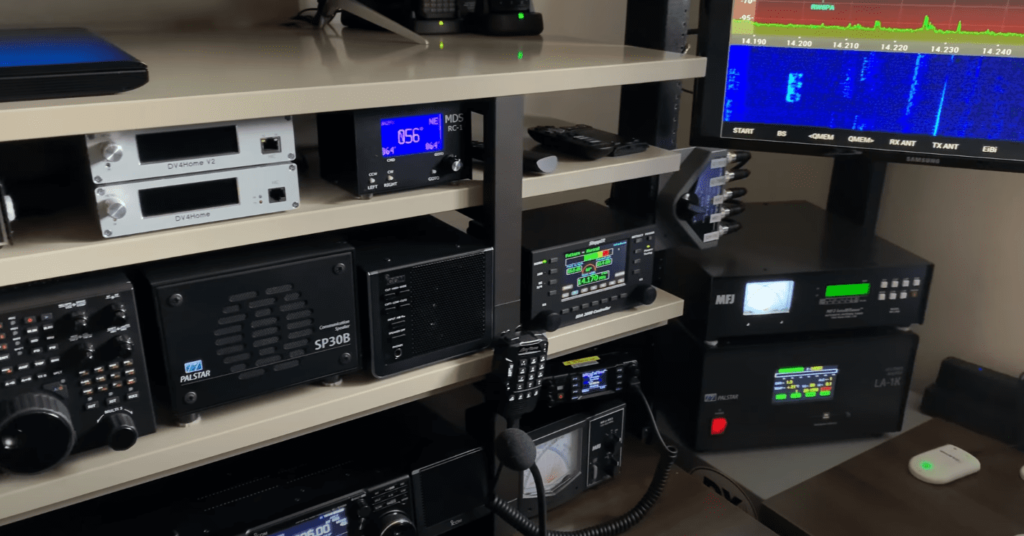
The vertical equipment rack offers an efficient, space-saving solution for organizing and accessing your ham radio equipment. Its vertical storage arrangement, effective cable management, and proper ventilation ensure a streamlined and well-maintained operating environment. With expandability options and integration possibilities, the vertical equipment rack can be tailored to meet the needs of your evolving ham radio station.
Mobile Desk
The mobile desk concept revolves around a portable and versatile workspace for ham radio operators. This design allows you to have a flexible operating setup that can be easily moved and adapted to different locations or situations. Here’s a description of the mobile desk idea:
- Portability: The key feature of a mobile desk is its portability. It is designed to be lightweight and easy to move, allowing you to set up your ham radio station wherever you desire. This is particularly useful for operators who may need to operate from different locations, such as field operations, events, or temporary setups.
- Compact and Folding Design: A mobile desk typically features a compact design that can be easily folded or collapsed for convenient transportation and storage. It may have folding legs or a collapsible frame that lets you quickly set up or dismantle the desk.
- Sturdy Construction: Despite its portable nature, a mobile desk is constructed to provide stability and durability. It is often made from sturdy materials such as aluminum or steel, ensuring that it can support the weight of your equipment and withstand regular transportation.
- Adjustable Height: Many mobile desks offer adjustable height options for different preferences and working conditions. This feature allows you to customize the desk’s height to ensure ergonomic comfort, especially when using it for extended periods.
- Integrated Cable Management: To maintain an organized workspace, mobile desks often incorporate cable management solutions. These may include built-in cable channels, clips, or hooks that help route and secure your cables, preventing them from tangling and getting damaged during transport.
- Storage and Organization: Despite their compact size, mobile desks often include storage features to help you keep your equipment and accessories organized. This may consist of shelves, compartments, or pockets where you can store cables, tools, and other essentials.
- Versatility: Mobile desks are designed to accommodate various ham radio setups and equipment. They typically provide sufficient surface area to accommodate a transceiver, microphone, computer, and other peripherals. Some models may have adjustable or removable sections to adapt to different equipment configurations.
- Integration with Accessories: Mobile desks can be designed to integrate with accessories such as monitor mounts, microphone arms, or keyboard trays to enhance functionality and ergonomics further. These additions make it easier to position and use your equipment comfortably, even in limited spaces.
- Stability Features: To ensure stability during operation, mobile desks may include features such as non-slip feet or locking mechanisms to prevent accidental movements or wobbling while in use.
- Aesthetics: Mobile desks come in various designs and finishes to suit different preferences and styles. They can range from sleek and minimalist designs to rugged and utilitarian aesthetics.
A mobile desk provides flexibility and convenience for ham radio operators who require a portable workspace. Its compact and folding design, along with features like adjustable height and integrated cable management, make it easy to set up and use in different locations. With storage options and the ability to integrate with accessories, a mobile desk offers a functional and versatile solution for operating on the go.
Adjustable Shelving
The adjustable shelving idea revolves around a flexible storage solution that allows you to customize the arrangement and configuration of shelves to accommodate various equipment sizes and organizational needs. Here’s a description of the adjustable shelving idea:
- Customizable Configuration: Adjustable shelving systems can configure the shelves according to your specific requirements. These systems typically consist of vertical standards or tracks that allow you to position the shelves at different heights or intervals. This versatility enables you to create shelf arrangements that perfectly fit the dimensions of your ham radio equipment and accessories.
- Height Adjustability: One of the key features of adjustable shelving is the ability to change the height of the shelves as needed. This is particularly useful when you have equipment of different sizes or when you need to accommodate additional items over time. You can easily raise or lower the shelves to create adequate space and ensure that each item is properly stored and easily accessible.
- Flexibility for Equipment Changes: As your ham radio station evolves, you may acquire new equipment or rearrange your existing setup. Adjustable shelving systems can adapt to these changes without requiring major modifications. You can simply readjust the shelf heights or even add or remove shelves to accommodate the new equipment arrangement.
- Easy Assembly and Adjustments: Adjustable shelving systems are designed for easy assembly and adjustments. They often feature simple installation methods, such as slotting the shelves into the vertical standards or using adjustable brackets. This lets you quickly set up the shelving system and adjust it whenever necessary.
- Versatile Storage Options: With adjustable shelving, you can store a variety of ham radio equipment and accessories. The shelves can accommodate transceivers, amplifiers, power supplies, antennas, books, manuals, and other items you may need for your station. Adjusting the shelf spacing allows you to create dedicated sections for different equipment categories, ensuring efficient organization and easy access.
- Cable Management: Effective cable management is essential for maintaining a tidy and functional workspace. Adjustable shelving systems often incorporate cable management features, such as cable routing holes or clips, that help organize and route cables along the shelves. This helps prevent cable clutter and simplifies maintenance and troubleshooting tasks.
- Stability and Weight Capacity: Adjustable shelving systems are designed to provide stability and support for your equipment. They are typically constructed from durable materials such as metal or sturdy plastic. The shelves are engineered to withstand the weight of your ham radio gear and accessories, ensuring a secure and reliable storage solution.
- Aesthetics: Adjustable shelving systems come in various designs and finishes, allowing you to choose a style that complements your personal taste and the overall aesthetics of your operating space. From sleek and modern designs to more practical or industrial looks, options are available to suit different preferences.
An adjustable shelving system offers a versatile storage solution for your ham radio equipment, providing customizable configurations, easy assembly, and adaptability to changing needs. With its ability to accommodate equipment of various sizes and promote efficient organization, adjustable shelving helps keep your operating space neat, accessible, and visually appealing.
Weather Station Integration
Weather station integration involves incorporating a weather monitoring system into your ham radio station setup. This integration allows you to gather real-time weather data, which can be valuable for various aspects of amateur radio operations. Here’s a description of the weather station integration idea:
- Weather Data Collection: By integrating a weather station into your ham radio station, you can collect a wide range of weather data. This may include temperature, humidity, barometric pressure, wind speed and direction, rainfall measurements, and more. These data points provide valuable information for monitoring weather conditions and understanding how they may impact your radio communications.
- Real-Time Monitoring: Weather station integration enables you to access real-time weather information. You can set up a display or connect the weather station to your computer or a dedicated monitoring device. This allows you to continuously monitor the current weather conditions without having to rely solely on external sources or forecasts.
- Antenna Performance Optimization: Weather data collected from your integrated weather station can help you optimize the performance of your radio antennas. You can assess potential obstructions or adjustments required for antenna positioning by tracking wind speed and direction. Understanding the impact of weather on your antennas can help you maintain reliable communications during various weather conditions.
- Safety and Severe Weather Alerts: Weather station integration provides an added layer of safety. Many weather stations have the capability to issue alerts for severe weather conditions such as thunderstorms, high winds, or rapid changes in barometric pressure. These alerts can help you take necessary precautions to protect yourself and your equipment during adverse weather situations.
- Weather-Based Propagation Analysis: Weather conditions play a significant role in radio wave propagation. Integrating a weather station into your setup allows you to correlate the collected weather data with observed changes in propagation characteristics. You can better understand and predict signal propagation for different frequencies and distances by analyzing how weather patterns impact radio signals.
- Data Logging and Historical Analysis: Weather stations often have the ability to log and store historical weather data. This feature enables you to review past weather patterns and compare them with your radio performance. By analyzing this historical data, you can identify correlations between weather conditions and radio propagation, helping you make informed decisions and optimize your operations.
- Integration with Software and Network: Many weather stations can be connected to software applications or networked systems. This integration allows you to transmit weather data to online weather networks, share it with other amateur radio operators, or integrate it with logging software. Additionally, some weather station software can generate graphical displays, charts, or maps to visualize the collected data.
- Personalized Weather Dashboard: You can create a personalized weather dashboard within your ham radio station setup. By integrating weather station data with your existing displays or computer interfaces, you can have a dedicated area to view and monitor weather information alongside your radio controls and other station components.
Integrating a weather station into your ham radio station gives you access to real-time weather data, enhance safety measures, optimize antenna performance, and improve your understanding of radio wave propagation. The ability to monitor and analyze weather conditions provides valuable insights that can enhance the effectiveness and efficiency of your amateur radio operations.
FAQ
Why do I need a dedicated ham radio desk?
Having a dedicated ham radio desk offers several benefits. It provides a centralized location to store and operate your equipment, promotes organization and efficiency, enhances ergonomics for comfortable operation, and creates a dedicated space for your hobby.
What are the key features to consider when choosing a ham radio desk?
Some key features to consider when choosing a ham radio desk include a sufficient surface area to accommodate your equipment, cable management options to keep cables organized, storage space for accessories and manuals, stability and sturdiness, and customization options to suit your specific needs.
What are some popular ham radio desk ideas?
Popular ham radio desk ideas include classic workbenches, multi-level desks, corner desk setups, modular desk systems, vertical equipment racks, mobile desks, and adjustable shelving. Each idea offers unique advantages depending on your preferences and available space.
How can I optimize cable management on my ham radio desk?
To optimize cable management, consider desks with built-in cable routing channels, cable clips, or hooks. You can also use cable management accessories such as zip ties, Velcro straps, or cable sleeves to keep cables organized and prevent tangling.
Can I customize my ham radio desk to fit my equipment and personal style?
Yes, many ham radio desks offer customization options. You can choose from various sizes, finishes, and configurations to suit your specific equipment needs and personal preferences.
Are there space-saving options available for smaller ham radio stations?
Yes, several space-saving options are available, such as corner desk setups, vertical equipment racks, and modular desk systems. These designs maximize the use of limited space while providing efficient storage and organization.
Can a mobile desk be a suitable option for portable operations?
Yes, a mobile desk is specifically designed for portability and can be a suitable option for portable ham radio operations. They are lightweight, easy to transport, and often feature folding or collapsible designs for convenience.
How can I integrate a weather station into my ham radio desk setup?
Integrating a weather station into your ham radio desk setup involves connecting a weather monitoring system to your station. This can be done by installing a weather station display or connecting it to a computer or dedicated monitoring device.
What are the advantages of integrating a weather station into my ham radio desk setup?
Integrating a weather station into your ham radio desk setup allows you to monitor real-time weather conditions, optimize antenna performance, receive safety alerts for severe weather, analyze weather-based propagation, and log historical weather data for analysis.
Remember to choose a ham radio desk that suits your specific needs, offers functionality and organization, and enhances your overall operating experience.
Related Video: Would You Like to Build the Best Ham Radio Shack Operating Desk?
Final Thoughts
The ham radio desk ideas presented here are a great starting point for anyone looking to create a functional and efficient setup for their radio hobby. By incorporating features like adjustable height, ample storage, and a comfortable chair, you can ensure that you have everything you need to enjoy your radio time to the fullest. Whether you are an experienced ham radio operator or just starting out, these desk ideas are sure to provide you with a great foundation for your hobby. So why not start planning your ham radio desk today?

